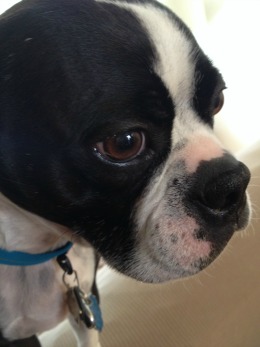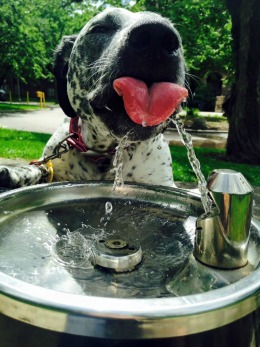June 22, 2015
Dogs don’t sweat!
Ok, technically they sweat a little bit through the pads on their paws, but they don’t sweat like humans do…
Dogs manage their body temperature by panting. By opening their slobbery mouths, they take advantage of evaporation to cool down the air that they breathe in. They also dilate their veins around their face and snout to cool the blood as it flows closer to the surface of the skin. Then the cool air and blood flows into their bodies and transfers heat back out through their snouts.
 Certain breeds, known as brachycephalic breeds, have been bred with a wider skull shape, which results in a short, flat face. This can cause a variety of different health issues; chief among them is overheating. Because they have such a small snout, they have less surface area within their mouth for the evaporative cooling effect to take place and a tougher time regulating body temperature.
Certain breeds, known as brachycephalic breeds, have been bred with a wider skull shape, which results in a short, flat face. This can cause a variety of different health issues; chief among them is overheating. Because they have such a small snout, they have less surface area within their mouth for the evaporative cooling effect to take place and a tougher time regulating body temperature.
English and French Bulldogs, Boston Terriers, Shih Tzus, Pugs, Boxers, Pekingese, Cavalier King Charles Spaniels, and some Chihuahuas are some of the more common brachycephalic breeds.
Any dog can get overheated. A healthy dog has a body temperature of 100.5-102.5 degrees fahrenheit. Highly stimulated play in a hot environment can lead to hyperthermia (the technical term for overheating). Extreme cases can lead to heat exhaustion–at about 105 degrees–and even heat stroke–at 107–with potentially serious and even fatal consequences. Because dogs have a higher body temperature than humans and a less efficient means for cooling off, what feels like a normal summer day to you may be unbearably blazing hot to your furry pal.
Signs of heat exhaustion include heavier, irregular, faster, and/or noisier breathing, disorientation or sluggish behavior, collapsing or convulsing, diarrhea, and vomiting. If you see these signs, immediately move the dog inside or under shade, give him a cool bath or spray him with a hose, and provide clean cold drinking water. If there is any question, proceed to the nearest veterinary office.
Preventative measures should be taken in hot weather: provide cool clean drinking water frequently, limit exuberant play to short periods of time, and rest often inside or under shade. Further precautions include exercising during morning or evening hours when it is cooler outside, and staying off of hot pavement.
If your dog is a brachycephalic breed, pay extra special attention whenever you go into the sweltering summer sun, as a small amount of exertion could result in a very rapid and dangerous overheating. And just like with humans, senior dogs and puppies are at an increased risk of heat exhaustion. Play it safe and play indoors when it’s too hot for your pup to safely get their exercise outside.

Nick manages our dog walking team at Rover-Time. He lives with his wife and son in Albany Park and together they share one Australian cattle dog mix named Squirrely and two formerly feral cats who are slowly learning to be socialized.

Recent Comments